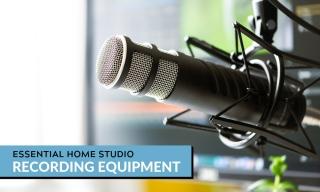
Essential Home Studio Recording Equipment
If you want to launch a new career and sell voice over services online, there are some things you’ll need. Recording studios date back to the 1800s when Thomas Edison invented the phonograph and changed the world. Fast forward over 100 years, and setting up a home studio has gotten a lot easier. Home studio recording equipment has become more affordable, more dependable, and of higher quality. It’s possible to make a home studio for around $500, but be careful not confuse affordable with cheap. Cheap equipment could lead to poor sound. Here’s what you need to get started.
A Good Computer
When it comes to either a Mac or PC, stick with what you know. There are good things about both, so whatever you’re used to is fine. You will want to get as much RAM as you can afford, though. More RAM won’t make your computer faster, but it will allow your computer to do more tasks at once. You don’t need to spend a ton of money on a new computer; you can always just add some upgrades to your current setup to increase performance.
DAW (digital audio workstation)
A DAW is any program used to record and edit your voice over or music. There are a lot of DAWs on the market right now, such as Sonar, Reason, and Studio One, and they all do pretty much the same thing. Do some research to find out which one is the best for your needs and is compatible with your computer at an affordable price.
Audio Interface
The audio interface is what turns your analog, acoustical sounds into digital recordings. Most interfaces will work with any DAW, but make sure they’re compatible; you don’t want to buy this twice. Like DAWs, there is a long list of interfaces out there; Apogee ONE and PreSonus AudioBox are just two of many on the market. Shop around, and find one that works for you.
Studio Microphone
The success of your voice over depends on the quality of your microphone, so get a good one. If your home studio is perfectly quiet, you can get a condenser microphone, but if there’s constant noise, go with a dynamic microphone. Dynamic is the most common type used because it doesn’t pick up background noise. The sound quality isn’t as sharp as a condenser because of that, though. Think it through, and get what will give you the best sound.
Headphones and Monitors
Of course, you need to hear what you’ve recorded to make sure it sounds good. Headphones will be crucial if there is constant noise around your studio. Using monitors and headphones together is always a good idea, too. If you listen to play back from two different sources, it will give you a better idea of how the audio sounds and what changes you might need to make.